Correlated free quantum systems
Contact: Jacques Robert
A - Atoms interacting with an optical nanofibre
This activity is part of a collaboration with the group led by Sile Nic Chormaic at OIST (Okinawa) and Etienne Brion, LCAR (Toulouse).
An atom, and its spectrum of states, is always interacting with its electromagnetic environment, be it the vacuum field or the field of a laser, for example. This interaction is strongly dependent on the boundary conditions that shape the spatial structure of the electromagnetic field.
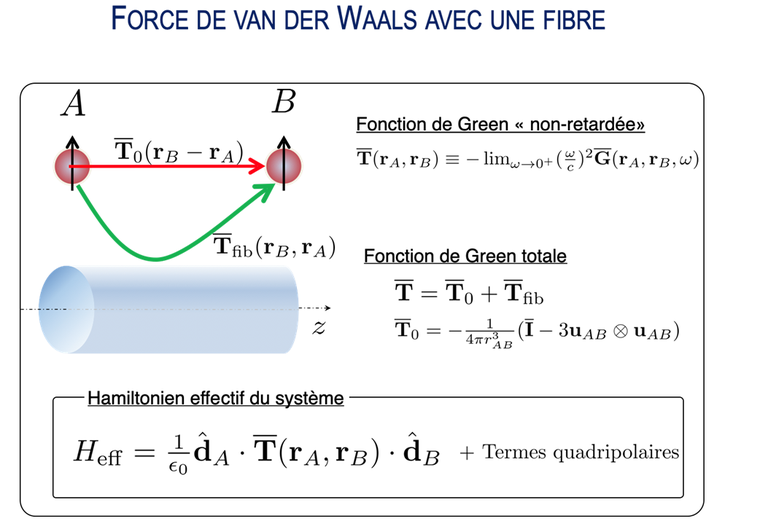
Interaction between two-atom dipoles via the transfer matrix T, which can be broken down into direct interaction via the free-space vacuum modes and interaction via the fibre modes (Erwan Stourm PhD thesis, December 2020).
Atoms interact via the electromagnetic field that surrounds them and it is possible to focus on certain modes of this field by placing these atoms close to an optical fibre. This makes it possible to distinguish between direct exchanges between atoms and those that take place through modes of the fibre field. The fibre field can be in a vacuum state or in a state created by a laser field. This could make it possible to detect the presence of atoms in the vicinity of the fibre via the perturbation linked to this laser field.
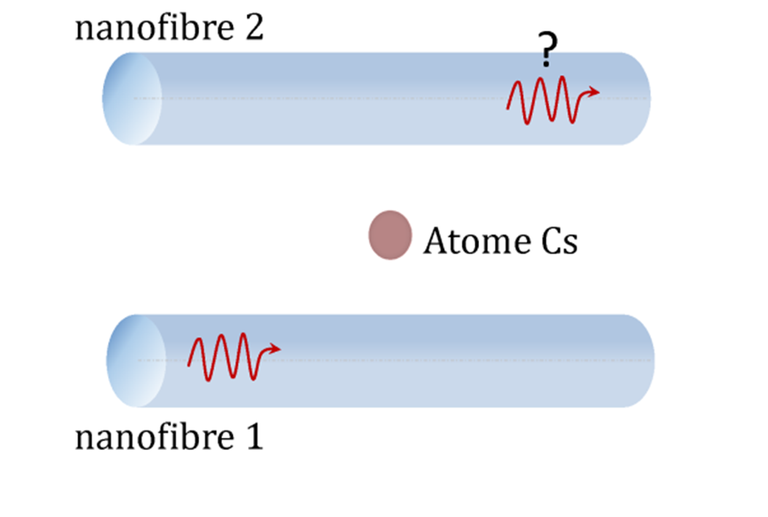
To make it easier to interpret the experiments, it is preferable for the atoms being studied to be highly excited (Rydberg atoms), because they are highly reactive to the electromagnetic field, and for these atoms to be as immobile as possible. Cold atoms are therefore placed close to a fibre whose field is very exalted, for example that of a nanofibre. Following the diagram described above, we have the outline of a system enabling information to be stored between atoms in a global and scalable way through their interaction with a fibre or with several fibres which can exchange information via the atoms.
B - Interacting hydrogen atoms and ion pairs
It has been shown that it is possible to obtain twin pairs of atoms, each in the H(2S) state, by dissociating a hydrogen molecule. The precise dynamics of dissociation are very difficult to follow and control. A complementary approach to this type of dynamics is to follow collisions from free states, i.e. collisions between atoms in a hydrogen jet, some of which are electrically excited. By focusing on the analysis of the correlations between the pairs obtained, we can see that these pairs can be neutral, partially excited or ions (e.g. H+ / H-), depending on the electronic excitation state of the two collision partners.
Twin atoms H(2S) + H(2S):
Pairs of twin atoms, each in the H(2S) state, obtained by dissociation of a hydrogen molecule by electron impact, can be considered as EPR-type pairs because the interaction between the two atoms is screened at a great distance. (Collaboration with Ginette Jalbert's team at LACAM UFRJ Brazil).
The figure shows the fragmentation of H2 by electronic impact into H(2S) + H(nL). The detectors are only sensitive to atoms in the H(2S) state, to ions and to FUV photons. The spectra represent the number of events recorded as a function of the time of flight between the collision centre and one of the two detectors.
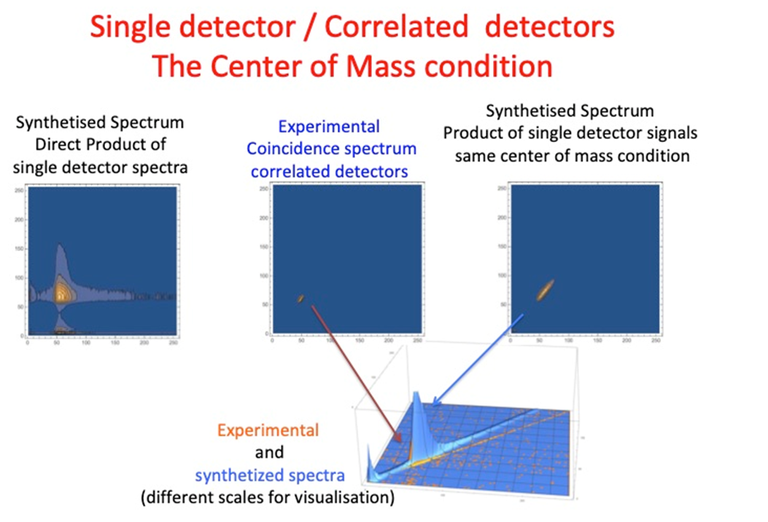
X axis: detector 1, y axis: detector 2. Colour code on spectra in density: blue no events, yellow then orange increasing number of events. The spectra at the top represent (1) on the left, a synthesised signal that is the simple product of the two time-of-flight spectra obtained for each detector independently of all the H(2S) + H(1S) or H(2S) + H(2S) etc. events, (2) in the centre, the signal when the two detectors operate in a correlated manner, i.e. the coincidence signal corresponding only to events where 1 H2 molecule gives two H(2S) atoms. (3) on the right, a synthetic signal obtained by multiplying the two time-of-flight spectra obtained independently and introducing an artificial conservation condition for the velocity of the system's centre of mass.
Although the shapes of the last two spectra appear comparable, the lower figure shows that their intensity is not, since it depends on the detection efficiency of each of the detectors, which operate differently in the case of correlated or independent detection.
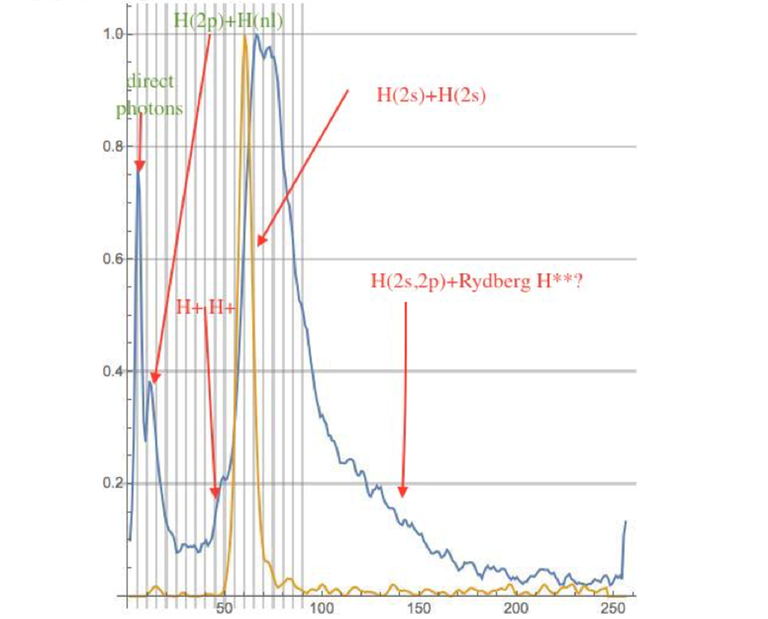
In blue: Time-of-flight spectrum obtained for a single detector Indicates the different possible contributions to the recorded signal.
In orange: projection onto this spectrum of the coincidence signal obtained with the two correlated detectors. The intensity scales have been adjusted to determine the widths and times of flight corresponding to this process.
Ionic Pairs :
One of the advantages of studying ionic pairs (H+ / H-) is that the Coulombian interaction continues without clipping to infinity, meaning that the fragments always remain in interaction. This makes it possible to study quantum-correlated interacting pairs (Darwin pairs). Note that this clearly distinguishes them from neutral pairs, for which the quantum correlation is not accompanied by a long-range interaction.
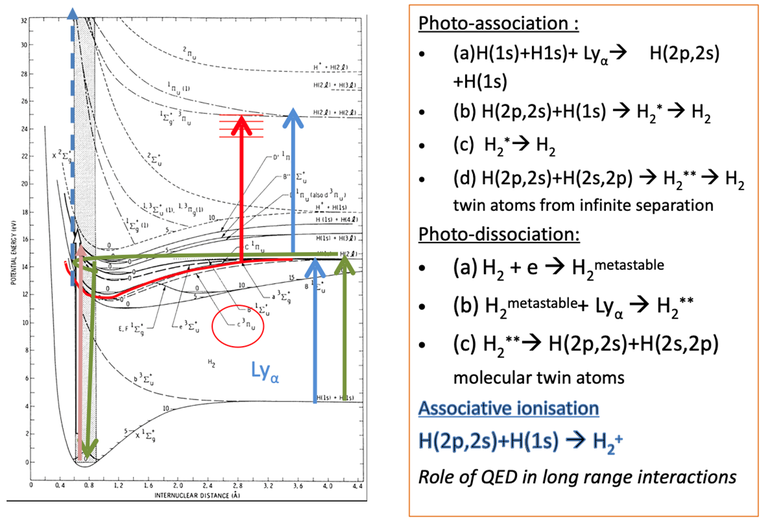
Molecular processes within a cold beam of hydrogen atoms with laser irradiation
Left to Right, Dissociation, Molecular Initial State: H2 (aΛb )->H(n,l)+H(n’,l’)
Right to Left, Association,:Atomic Initial States H(n,l)+H(n’,l’) -> H2 (aΛb )
For these ionic systems, it is easy to apply an electric or magnetic field to the resulting ions and thus study their re-collision. In this respect, these pairs are similar to the ion-electron pairs used to create high-order harmonics in an intense laser field. The case of the H+ / H- pair is also unusual in that, at least at long distances and with respect to nuclear spin, it is equivalent to that of two particles with no structure and no electron spin, since the proton has only one nuclear spin and, in the case of the hydrogen anion, the nuclear spin is carried by the proton and its two electrons are in a single stable electronic state with S symmetry.
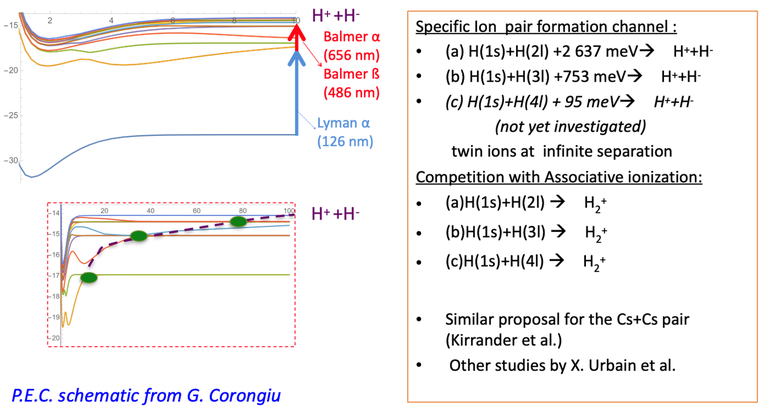
Molecular processes between hydrogen atoms, formation of ion pairs by collision: H(n=2,3,4;l)+H(1s) -> H+ +H-.
Figure on the left, top: adiabatic potential curves, bottom: potential curves for excited states alone and overlay of the ion interaction curve and crossings with the adiabatic curves.
Experimentally, we propose to use a jet of atomic hydrogen that is dense and as cold as possible. The hydrogen atoms are produced by radiofrequency or microwave discharge, and the resulting gas is then cooled by cryogenics. Under the effect of one or more lasers, the hydrogen atoms are brought into the first electronic states. For direct 1-photon excitation, we need lasers capable of producing tunable Lyman radiation (alpha or beta) with a narrow spectral range. The main problem is obtaining sufficiently intense alpha Lyman radiation (121 nm), if not in continuous mode, then at least in long-pulse mode. Whatever the details of the method used, a high-performance frequency mixing device is required. The lasers will be stabilised using optical combs (CEPR COMB-IdF and REFIMEVE network).
We are studying the possibility of using a plasma created in a hollow capillary filled with gas (hydrogen) either to obtain jets of atoms (ions) or to generate alpha Lyman harmonics.
